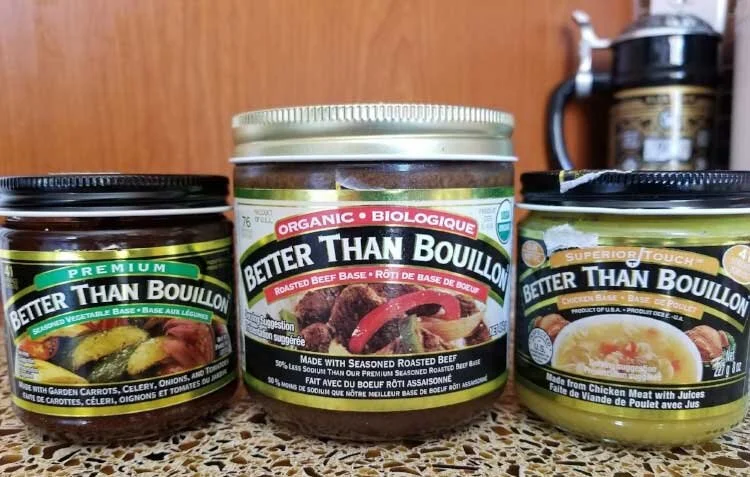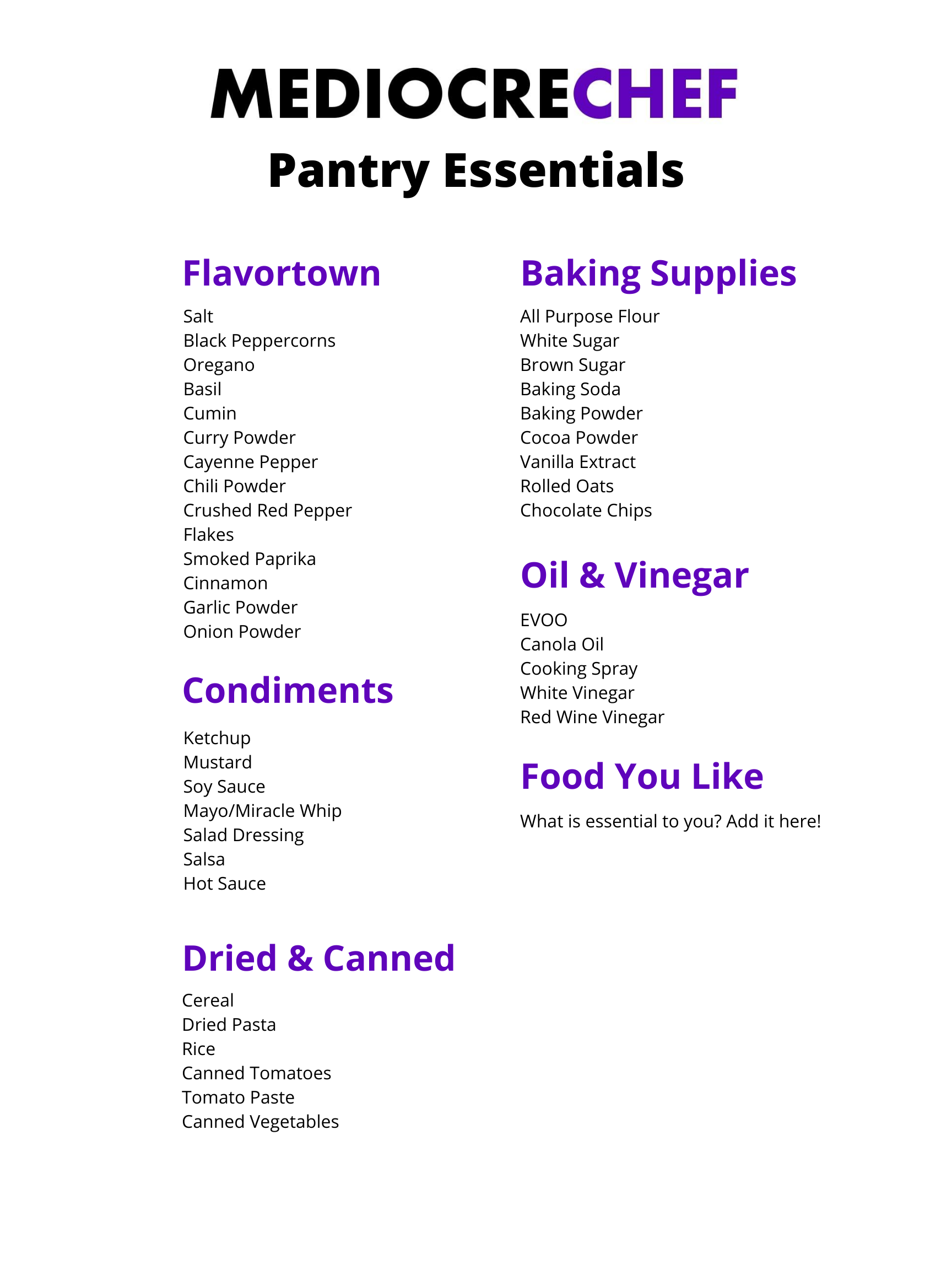Pantry Essentials: A No-Nonsense List of What You Actually Need According to Two Caucasians
Hey there champ.
Did you just move out of your mom’s basement?
Congratulations on finally leaving the nest and taking your first step into the real world! Now you have to pay for rent, your Netflix account, and oh, what’s this? You need to start cooking on your own.
Yes, that’s right, you’re taking your first steps into the real world, which means your parent’s won’t be cooking for you every day. Or if you did cook while at home, it means relying less on boxed mac and cheese. Sure, you could order delivery or takeout every day, but that’s going to hurt your wallet.
Chances are, if you’re reading this, you’re probably a millennial or zoomer (Gen Z) and have no idea where to start or what to buy for your kitchen pantry. Fear not! We have meticulously compiled a list of pantry staples you should keep stocked. Seriously, we argued over this for like an hour and half. So go on, guilt trip your mom into taking you to the grocery store as we present to you: The Mediocre Chef’s List of Pantry Essentials for the New Chef. (A mouthful, isn’t it?)
Flavourtown
Salt
Black Peppercorns
Dried Herbs
Spices
Better Than Bouillon
Salt and pepper makes the world go ‘round — everything tastes better with it. The dried herbs and spices you buy to start out are ultimately up to you and what kind of food you want to cook. We won’t lie to you and tell you that you absolutely must have paprika in your spice rack, when really you’ll only ever use it to make deviled eggs look good. (More seriously, smoked paprika is awesome.)
That being said, a short list of spices and dried herbs we’d recommend, gun to our heads, are: oregano, basil, cumin, curry powder, cayenne pepper, chili powder, crushed red pepper flakes, smoked paprika, and cinnamon. We also recommend having a bottle of garlic powder and onion powder on hand — they're great for rubs and spice mixes, and can be used in a pinch when a recipe calls for the fresh stuff but you don’t have it. (Fresh garlic and onion are items we always try to have on hand too!)
We’re not sponsored by Better Than Bouillon, but we’d like to be.
Continuing on the train to Flavourtown, we recommend Better Than Bouillon. It’s super flavourful and you can use as much as the recipe calls for, so you don’t have to waste half a box of beef broth because you don’t need a full litre for a recipe. We won’t judge you for not making your own homemade stock, especially if you’re new at cooking. (Plus making stock is a chore and a half.)
Vinegars
White Vinegar
Red Wine Vinegar
Rice Wine Vinegar*
Do a quick Google search for pantry essentials and you’ll find that most lists have a dedicated vinegar section — and almost all of them recommend that you have 3-5 different kinds of vinegars on hand. The truth is, as a beginner, you’ll almost never need most of these vinegars.
White vinegar is an all around workhorse — it does a lot of things well, but nothing great. This is going to be the only item on here where you’re just going to have to trust us. You will need white vinegar — whether it’s for boiling eggs or cleaning up your nasty ass kitchen.
Red wine vinegar is versatile — it’s great for salad dressings, vinaigrettes, and marinades, which is why we’ve added it to our list. Balsamic vinegar, apple cider vinegar, malt vinegar, champagne vinegar (the list goes on) all have their own place in the kitchen too. But to start, these two vinegars will enable you to begin experimenting with acidity in your cooking!
*If you find yourself cooking a lot of Asian recipes, rice wine vinegar will also be a staple in your pantry.
Oils
EVOO
Neutral Flavoured Oil (Canola, Vegetable, or Grapeseed)
Cooking Spray
Sesame Oil*
Ever since we were young and watched Rachael Ray use gallon after gallon of Extra Virgin Olive Oil (EVOO) in her cooking, it’s been hard not to follow suit. It took us until we were in our early 20s to break out of the habit and experiment with different oils.
Naturally, we recommend keeping a good quality EVOO in your pantry. You should also have a neutral flavoured, high smoke point oil such as canola, vegetable, or grapeseed on hand as well. Because, as it turns out, olive oil isn’t the best oil for deep frying things in. Its low smoke point (the temperature at which the oil begins to smoke) and intense flavour means the food won’t get hot enough to cook quickly, and the olive oil will impart a strong flavour on whatever it is you’re frying. Hence why having a neutral flavoured oil with a high smoke point is a good idea.
Also, don’t use EVOO for making cupcakes. Brittany did that one time and it was gross. Most baking recipes mean a neutral oil when they call for oil.
Be smart. Use the kind of oil the recipe calls for, you’re not good enough to substitute ingredients yet.
*Sesame oil is a must-have if you love cooking Asian cuisine, while cooking spray is perfect for making sure your cookies or french fries don't stick to your tray in the oven.
Baking Supplies
All Purpose Flour
White Sugar
Brown Sugar
Baking Soda
Baking Powder
Cocoa Powder
Vanilla Extract
Rolled Oats
Chocolate Chips
If you bake, or want to get into baking, here are the basics you’ll need to get you started. Maybe you’ll need to buy an extra ingredient or two for a new recipe you want to try, but these will get you started.
If you don’t like baking, you’ll at least need flour for thickening and frying, and probably some sugar too. We don’t need to explain that one, do we?
2020 getting you down? Bake a cake! Cake makes everything better.
Fridge Condiments
Ketchup
Mustard
Soy Sauce
Mayo and/or Miracle Whip
Salad Dressing (your favorite, or make your own)
Salsa
Hot Sauce*
We’re breaking our “rules” for this post here. We wanted to originally just include stuff that wouldn’t perish. Well, this stuff in your fridge won’t perish for a long time, so we’re making an exception. This is stuff that we commonly use — if you frequently cook a cuisine such as Japanese or Thai for example, the condiments you carry in your fridge will look very different.
We have not included Worcestershire Sauce on our list because although we have it in our fridges, we rarely use it.
“That’s such an old Boomer thing.”
*Don’t like hot sauce or sriracha? Don’t buy it. Duh.
Dried & Canned Goods
Dried Pasta
Rice
Canned Tomatoes
Tomato Paste
Canned Vegetables
Cereal
{insert thing you eat a of lot here}
So obviously you can’t live off of spices, condiments, vinegar, or cooking oil — you actually have to eat something. We recommend keeping two different types of dry pasta on hand, and no, this doesn’t mean instant ramen noodles and Kraft macaroni and cheese. Keep both a long pasta (spaghetti, linguine, fettuccine) and a short pasta (farfalle, rotini, penne, macaroni) in your pantry.
🍝 Mediocre Tip: Certain sauces work best with certain types of noodles, which is why we recommend having at least two different types in your pantry at all times. A thicker red sauce with chunks of beef in it will probably be better suited to a short pasta that has crevices and places for the meat to rest, whereas a thin sauce made with oil and garlic will probably be better suited to a longer noodle with more surface area.
There are tens of thousands of different types of rice. We aren’t going to tell you which one you should have in your pantry, but we like jasmine and basmati. They’re fragrant and work well with a multitude of dishes! Keep your favorite type of rice on hand.
Canned goods are a tricky subject — what exactly is essential? Well, it depends on what you like to eat. We included canned tomatoes on our list because they come in a variety of options (whole, diced, stewed, strained, sauce) and because we’ve cooked with them our entire lives. If you’re a tomato hater or you don’t find yourself needing tomatoes for sauces, soups, etc, then feel free to omit them. We’ve also included tomato paste as a canned good, although it’s much better if you can find it in a tube so you can easily use as much as you need when you need it.
On a final note, if you love canned tuna and eat tuna sandwiches everyday, canned tuna is a pantry staple. If you love beans, and cannot live without them, beans are a pantry staple. Ultimately, the canned goods you have on hand are determined by your personal preference. This is a bit of a wishy-washy statement, but again, we don’t want to bullshit you and tell you that YOU ABSOLUTELY, POSITIVELY MUST HAVE BLACK BEANS AND CHICKPEAS ON HAND OR THE PANTRY GOD WILL RAIN DOWN A PLAGUE OF PESTILENCE UPON YOUR KITCHEN. You get it, right?
Congratulations!
You’ve just acquired what we figure are the most essential things for your pantry.
Pantry Upgrades
Where do you go from here? If you’re looking to take your cooking game to the next level we have a brief list of additions — a collection of pantry essentials for the Mediocre Chef.
Nuts
Elevate your dish with almonds, pistachios, walnuts, or peanuts! Cooking fish? Try adding walnuts or almonds to your breading. Making a cheese ball for a party? Roll it in chopped pecans. Add nuts to salads, or if you like to bake, in brownies, cookies, and cakes. You can also roast nuts to bring out their flavour, or create candied nuts by baking them with sugar and butter. Mmmm.
Fresh Herbs
There are certain herbs that are fine to have on hand in dried form such as oregano, sage, thyme, and rosemary — these herbs keep their flavour during the drying process. However, some herbs are best used fresh such as basil, parsley, dill, mint, and chives (though technically chives are a vegetable). We also like having fresh rosemary and thyme on hand, but the dried herbs are just as good. Fresh herbs can also be used to make your dishes visually go from looking like they were cooked in a college dorm to a 5-star Michelin meal.
Sidenote: Yes, we know that fresh herbs belong in the fridge and not in the pantry. But they're important, so we're including them on our list.
Not that kind of herb.
Breadcrumbs
Breadcrumbs are a fantastic way to step-up your homemade mac and cheese game. They are also the basis for numerous breaded and deep fried dishes such as chicken parmesan, mozza sticks, and fish and chips just to name a few. If breadcrumbs are on your shopping list, we recommend getting Panko breadcrumbs, a Japanese-style breadcrumb that is light and airy. Or you can make your own breadcrumbs by taking some old bread, drying it out in the oven on a low heat, and crushing it up in a ziploc bag.
Other Vinegars & Acids
If you want to begin your journey into a world of new ingredients, might we suggest starting with some vinegars? Balsamic vinegar, apple cider vinegar, and white wine vinegar are three that we also recommend having on hand, as they each have their own acidity and flavour profile. Lemon juice is another great acid to have in your kitchen. Experiment and see which one works with what dish! Or follow the recipe. Your choice. (You should probably follow the recipe.)
Other Salts
For real, there are so many different types of salt you can buy. It’s a bit ridiculous really, because, at their core, they’re all the same. So why do we recommend different types? Simply put, where the salt is harvested from will determine how many extra minerals are bound to each chunk (the different minerals will change the taste of the salt slightly), and the grain size and shape will impart certain textures to your dish. On top of a fine salt, we also recommend a good kosher salt with a slightly larger grain size as well as some sea salt flakes. Kosher salt is a great all purpose cooking salt as it dissolves easily, and is a great salt for dressing up a dish due to its larger grain size. Salt flakes are almost purely for plating purposes — they can make your steak look absolutely amazing and also add a great crunch to every bite.
We would like to be as suave as this guy one day.
Pantry Essentials Checklist
Going shopping soon? Print this checklist and take it with you!
We left space to write down what’s personally essential to you!
Did your wallet cringe after reading this post? If you’re starting from scratch, your first grocery bill is going to be expensive. (We won’t sugar coat it.) However, many of these essentials will last a long time before you have to replace them again.
Think we’re missing a pantry staple from our list? Comment below and let us know!
Author’s Note: We’re two white people. Obviously this list isn’t going to work for you if what you cook isn’t mainly Western cuisine. We don't have the knowledge or expertise to create a list for every type of cuisine! However, if you are mostly cooking Western food, we do recommend branching out and trying new things once you’re settled into your new place and have money to splurge on a few new ingredients. The world of food is vast and exciting. Experiment!










